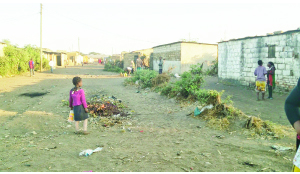By JOWIT SALUSEKI –
BY virtue of Zambia’s colonial past, township names and streets have been predominantly British as at independence.
But during the post-independence era, the concept of localisation began to take root.
Local people began to drift towards using indigenous names as evidenced by the changes effected to provincial centres such as Fort Jameson (Chipata), Fort Roseberry (Mansa) and Abercorn (Mbala) to state just a few.
As for townships, Lusaka, for instance, gives a clear perspective of this development when one samples street names in Woodlands and Kabulonga residential areas.
Some of these townships and street names have hardly changed and in this context one would still find street names like Cedar Road in Woodlands and Sable Road in Kabulonga.
The other low-density areas are Northmead, Rhodes Park, Roma, Thornpark, Villa Elizabetha and Emmasdale.
In this vein, it is worth noting that Lusaka started off with only five recognised townships namely Chilenje, Matero, Kabwata, Chibolya and Chawama.
But over the years, the capital city has seen a proliferation of unplanned settlements which gave rise to the shanty township phenomenon.
Some of the townships carry names of original colonial settlers which have lingered on to the present day, like John Laing (locally known as John Lenge), John Howard, Marrapodi, Kalikiliki, Ng’ombe, Chazanga, Kabanana and Linda.
Chawama, for example, was in the pre-independence days known as Robert Township.
While the lifestyle in low-density areas has remained the same even after the colonialists left the country, the situation is different in most sprawling areas.
Thomas Phiri, who has lived in Chawama Township his entire life, knows better about the happenings in the locality.
According to Mr Phiri, the place which is now called Bauleni Township used to be a farm owned by a Mr Bollen while townships such as Chibolya and Kanyama, among others, were used to accommodate Government workers such as office messengers and other civil servants during the colonial era.
“Chibolya Township became notorious with crime when Zambia became independent in 1964 as people started constructing makeshift structures where they brewed Kachasu (a traditional highly potent alcoholic beverage),” Mr Phiri explained.
He said the State used to install speakers in community halls and other social centres where people gathered to listen to radio programmes broadcast from Ridgeway area.
In Kitwe, which is one of the Copperbelt Province mining towns, Mulenga Township off the Ndola-Kitwe dual carriageway and Racecourse are some of the habitats that came up during the 1950s and ‘60s.
Racecourse was created by workers who were employed by the then Copperbelt Turf Club which managed horse racing during the 1950s through to the mid-1970s.
When Copperbelt Turf Club finally closed and relocated to South Africa around 1975, the township started hosting various people including retirees.
It is now one of the biggest shanty townships on the Copperbelt spreading over to Garnetone residential area.
The formally established townships were Ndeke and Chimwemwe, while the low-density areas were Parklands, Riverside, Nkana East and Nkana West.
The Copperbelt’s provincial capital Ndola has low-density areas such as Kansenshi and Northrise, but it is the high-density areas like Nkwazi, popularly known as Sinya, Chipulukusu and McKenzie townships where mischief is the order of the day.
Drug abuse and juvenile delinquency is rife in these locations such that teen pregnancies have taken a toll among teenage girls.
Reverting to the Central Province, Kabwe, the legendary lead, zinc and vanadium mining town boasts Poleni, Chowa, Kasanda, Chimanimani, Ngungu and Bwacha townships.
Here, the high-density areas are Nakoli in the north-east and Makululu in the south-west within the precincts of the town.
In Luapula Province’s Mansa for instance, Senama (lie on your back) Township is renowned for its way-ward life while sprawling townships like Malota in Livingstone, Kambotole in Kasama, Mulambwa (also known as ‘dark city’) in Mongu have all become synonymous with social ills.
In North –Western Province, a visit to Mwinilunga is said to be incomplete if one has not stepped a foot in the sprawling Kabanda Township.
The township is positioned on the south-end of the town as one departs the district heading to the newest district of Ikeleng’i on the Mwinilunga–Ikeleng’i-Jimbe Road, connecting to the neighbouring Angola.
The defunct Mwinilunga pineapple cannery, which collapsed some years back, was set up less than a kilometre from this popular township that never goes to sleep at night.
The locals call it Kabanda yejima yejima (meaning Kabanda where everything is found).
Just like any other Zambian high-density area, Kabanda Township is also notorious for some of its red-eyed youths who can be spotted in small hordes, openly smoking cannabis with impunity.
In Muchinga Province’s Mpika District, townships such as Kamwanya, Shanghai and Chitulika are some of the locations where social life among its inhabitants is the order of the day.
One thing for sure is that despite the way of life in most Zambian townships, the people in these localities live in harmony with one another.







